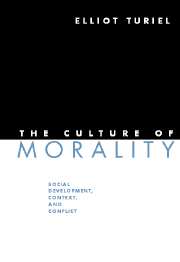Book contents
- Frontmatter
- Contents
- Preface
- 1 Introduction
- 2 Striving for Community
- 3 Discontents Revisited
- 4 Social Judgments and Social Contexts
- 5 The Development of Moral and Social Judgments
- 6 Social Thought and Social Action
- 7 Social Harmony and Social Conflict
- 8 Justice, Heterogeneity, and Cultural Practices
- 9 Social Hierarchy, Subordination, and Human Capabilities
- 10 Perspectives on Cultural Practices: More Than One
- 11 Subversion in Everyday Life
- 12 Conclusion
- References
- Index
5 - The Development of Moral and Social Judgments
Published online by Cambridge University Press: 05 June 2012
- Frontmatter
- Contents
- Preface
- 1 Introduction
- 2 Striving for Community
- 3 Discontents Revisited
- 4 Social Judgments and Social Contexts
- 5 The Development of Moral and Social Judgments
- 6 Social Thought and Social Action
- 7 Social Harmony and Social Conflict
- 8 Justice, Heterogeneity, and Cultural Practices
- 9 Social Hierarchy, Subordination, and Human Capabilities
- 10 Perspectives on Cultural Practices: More Than One
- 11 Subversion in Everyday Life
- 12 Conclusion
- References
- Index
Summary
We have seen thus far that the notion of character has been used in more than one way – some uses more general than others. The general uses of character refer to group, cultural, or national types and subtypes, and are seen to be represented in the makeup of individuals. The link of this type of use of the term character to morality is ambiguous. On the one hand, group or national character is seen to encompass the moral perspective of society. On the other hand, the national character identified is often criticized on moral grounds. When Bellah et al. (1985) and Etzioni (1993), for example, criticize the individualism of American society, they are simultaneously trying to capture the nation's character and scrutinize it from a moral vantage point. However, the moral criteria for the criticism of the society are left largely unspecified. Character types like the inner-directed and other-directed, as put forth by Riesman (1953), appear to contain moral and nonmoral features – but without specification of characteristics that would distinguish the moral from the nonmoral.
The less general uses of the notion of character are closely linked to morality through identification of particular traits – such as honesty, compassion, courage, responsibility, and loyalty. Possessing the specific traits, along with associated habits of behavior, is seen to constitute morality. The term character is also used (sometimes colloquially, as well) to refer to individuals who live in a moral way – in the sense that they are “persons of character.”
- Type
- Chapter
- Information
- The Culture of MoralitySocial Development, Context, and Conflict, pp. 94 - 118Publisher: Cambridge University PressPrint publication year: 2002



